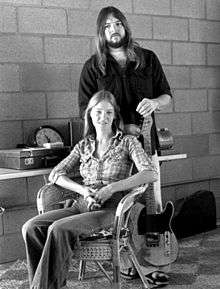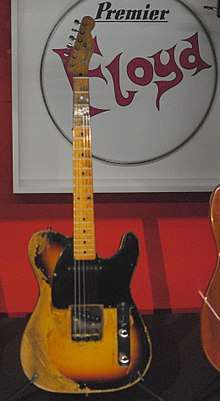Seymour W. Duncan
Seymour W. Duncan is an American guitarist and guitar repairman and a co-founder of the Seymour Duncan Company, a manufacturer of guitar pickups, bass pickups, and effects pedals located in Santa Barbara, California. Born in New Jersey, Duncan grew up in the 1950s and 1960s, during a time when electric guitar music grew into greater acceptance. In a 1984 interview [2] Duncan talks about when he started to play guitar:
- I guess when I was about 13. I used to watch the Ted Mack Show and the Ricky Nelson Show and watch James Burton play who was, and still is, one of my favourite guitar players. He was one of the big influences on Tele sounds - you know I basically play Telecasters and Fender Strats.
Seymour W. Duncan | |
|---|---|
 Seymour Duncan and Cathy Carter Duncan | |
| Born | 11 February 1951 New Jersey, United States |
| Occupation | Luthier, Musician |
| Years active | 1975-present |

Duncan began playing clubs and during one show, his Fender Telecaster's lead pickup broke, forcing him to play the rest of the night on the rhythm pickup. Necessity being the mother of invention, Duncan rewound that lead pickup on a record player spinning at 331⁄3 rpm.
While he developed his playing skills, Duncan's knowledge of how guitars work grew. Duncan took every chance he had to talk with players about guitars, tone and electronics. After spending time with musicians such as Les Paul and Roy Buchanan, Duncan realized that it was his guitar, and not his playing, that prevented him from producing those wonderful tones that defined great players. Suddenly, and forever, Duncan was hooked on the dynamics and character differences of pickups.
As Duncan tinkered with materials and techniques, his bag of tricks grew and grew. At Les Paul's suggestion, he moved to England in the late 1960s where his intention to play soon mixed with the opportunity to further his pickup research working in the Repair and R&D Departments at the Fender Soundhouse in London. It was here that he did repairs and rewinds for such artists as Jimmy Page, George Harrison, Eric Clapton, David Gilmour, Pete Townshend, Jimi Hendrix, Peter Frampton and his guitar hero Jeff Beck. It was through his work with Beck in particular, that Duncan honed his pickup winding skills—some of Duncan's first signature pickup tones appear on Beck's early solo albums. Duncan's sabbatical in England resulted in a flock of new fans and friends.[3] Duncan came back to the United States and eventually settled in California. He established contact with people such as Leo Fender, Les Paul and Seth Lover (inventor of a humbucking pickup) and continued learning about and making pickups. Demand for his custom pickups grew and in late 1978 together with Cathy Carter Duncan, he started his own company, Seymour Duncan Pickups. Today the company has over 120 employees.
Fender Custom Shop makes a Seymour Duncan Signature Esquire. Duncan is still involved in designing and fabricating pickups at the factory as well as playing guitar and making appearances at clinics and conventions.
Albums
| Year | Album | Artist | Credit |
|---|---|---|---|
| 1975 | Home of the Brave | Chris Rainbow | Bass |
| 1978 | Looking Over My Shoulder | Chris Rainbow | Bass |
| 1992 | East Side Story | Kid Frost | Guitar, Engineer, Mixing |
| 1993 | American Music | Bugs Henderson and the Shuffle Kings | Guest Appearance |
| 1996 | 1996 | Merle Haggard | Guitar (Electric) |
| 1997 | Guitar Zeus, Vol. 2: Channel Mind Radio | Carmine Appice's Guitar Zeus | Performer |
| 1998 | Lost Years | Dave Mendenhall | Guitar |
| 2000 | Best of Chris Rainbow, 1972–1980 | Chris Rainbow | Guitar |
| 2006 | Ultimate Guitar Zeus | Carmine Appice Project | Guitar |
| 2011 | TBA | Seymour Duncan | Guitar |
References
- Pink Floyd: Their Mortal Remains exhibition label
- Music UK magazine p.74 (May 1984 issue)
- Archived August 1, 2010, at the Wayback Machine